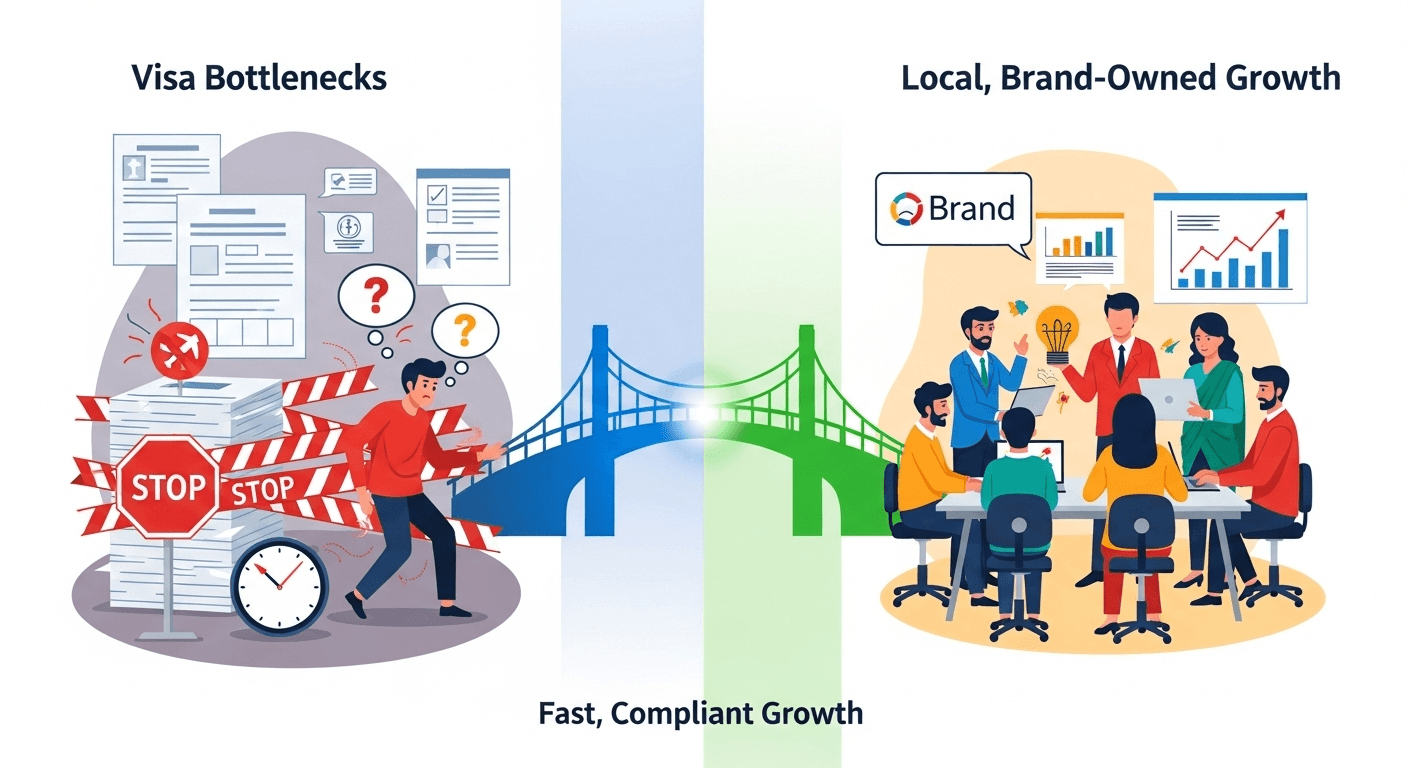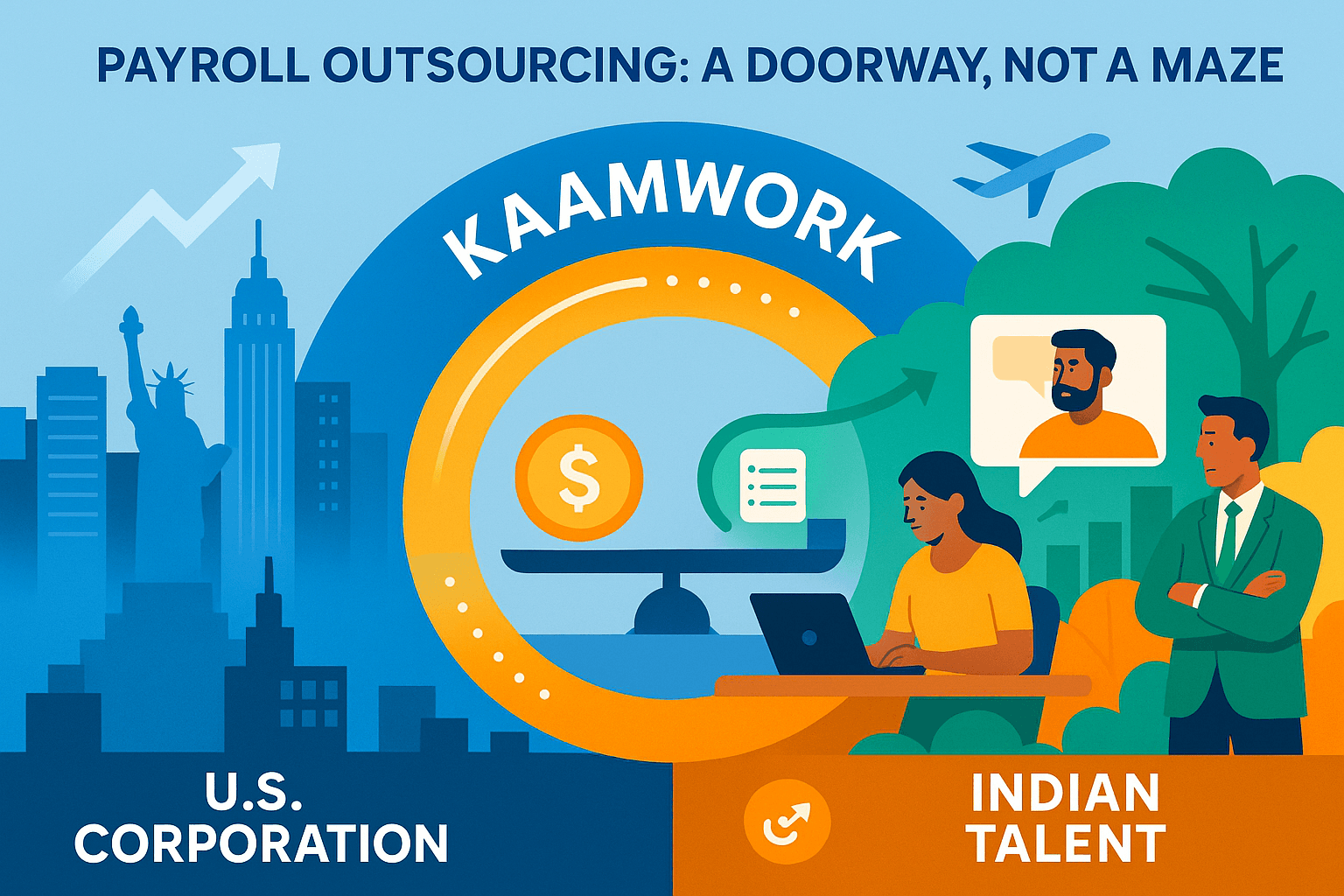India work visa rules explained: hiring employees vs. building teams locally
Discover how to build compliant, cost-effective teams in India quickly—boundless hiring without visa delays. Maximize talent, reduce costs, accelerate growth.
ByNilesh@kaam.work / October 3, 2025 / 6 min read

When U.S. companies consider setting up in India, the default assumption is usually simple: move a few employees on work visas to establish an initial presence. At first, this looks like the logical step. Relocate trusted leaders, give them time on the ground, and let them build out operations.
But the India work visa is not designed for scale. It carries strict eligibility criteria, multiple documentation, and a wait time of months. While it may be easier to move a few executives, the visa process for an entire team can be highly problematic.
What international businesses are discovering instead is that employing directly in India is quicker, less expensive, and more conducive to sustained growth. With the right compliance model, teams can be built in weeks without sacrificing brand ownership or legal certainty.
How the India work visa works
To understand why visas slow down expansion, it is worth looking closely at the system itself.
Who qualifies
India’s employment visa is reserved for foreign nationals with specialized skills. Typical candidates include senior managers, niche technical experts, or specialists brought in to train or transfer knowledge. Most applicants must also meet a minimum salary threshold of around USD 25,000 per year. That condition alone rules out mid-level or entry-level roles.
Requirements and restrictions
Every visa application requires sponsorship from a registered Indian entity. Without an Indian branch office, subsidiary, or joint venture, a firm cannot sponsor a visa. Other requirements include:
- Contracts and proof of professional qualifications.
- Employer financial records.
- Restrictions that bar routine or clerical roles, which Indian workers must fill.
Visas are generally valid for one or two years and renewable, although renewals tend to take as long as the first application.
Common roadblocks for employers
Its approval process is multi-agency. Documents are reviewed, and any discrepancy sends the file back to be revised. Renewals require companies to begin almost from scratch, submitting many of the same documents again. In practice, it is common for applications to stretch over several months.
For U.S. executives who expect hiring cycles to move quickly, this delay is a serious handicap.
Why work visas slow expansion
Companies usually discover the limitations of work visas only after they have begun the process.
Administrative burden
Each application can take weeks of HR effort. Internal teams must prepare contracts, certifications, and legal justifications. Because an Indian entity is required to sponsor the visa, companies without one must either set up locally—a process that can take three to six months—or find a partner willing to act as sponsor.
Limited use
Even after securing visas, companies can relocate only a handful of people. The system was never intended for mass hiring. For a team of 20 or 50 employees, visas are simply not an option.
Employee challenges
Relocating staff from the U.S. to India is costly and disruptive. Relocation packages typically include housing allowances, schooling for children, relocation fees, and tax equalization benefits. These can add over USD 100,000 annually per employee on top of base salary.
Adjustment is another issue. Relocated staff may need months to adapt to cultural and workplace differences. Some leave early, creating turnover risks.
Why local hiring is the smarter alternative
Because of these barriers, most global companies now prefer to hire directly in India. This strategy eliminates visa requirements while providing access to one of the largest talent pools in the world.
Access to a deep talent pool
India boasts over five million software professionals, with high density in Bangalore, Hyderabad, Pune, and Gurgaon. Outside of technology, India graduates thousands of finance, data analytics, and product management students every year.
Local hires are available to start contributing right away, without the hassle of relocation or cultural transition.
India's labor force is also spread out geographically. Tier-1 cities continue to be magnets for talent, but tier-2 cities like Jaipur, Coimbatore, and Kochi are no longer the only sources of skilled engineers and analysts.
Remote work has fueled this trend, enabling companies to tap talent outside large hubs. For U.S. managers already used to distributed teams, this is consistent with what they already do and makes hiring in India all the more appealing.
Proof from global capability centres
Global Capability Centres (GCCs) illustrate the strength of the local hiring model. Over 1,700 GCCs are functioning in India today, employing nearly two million experts and making a contribution of approximately USD 64 billion each year.
Large multinationals continue to expand through this route. Costco announced its first GCC in Hyderabad with 1,000 hires. Japanese companies such as Sony, Toyota, and Hitachi have taken the same approach. Instead of relocating expatriates, they build directly on the ground.
Costs of local hiring
By contrast, local employees are hired at competitive Indian salary levels. Savings can be 50% or more compared to equivalent U.S. roles, with overhead savings of up to 80%. Using an Employer of Record (EOR) model, companies pay a flat monthly fee—around USD 599 per employee in Kaamwork’s case—on top of salary.
To put this in perspective: relocating five managers might cost USD 500,000 annually in allowances alone. For the same amount, a company could hire 20 local employees through an EOR model—quadrupling headcount while embedding the team directly in the Indian market.
How Kaamwork enables local hiring
The barrier for many companies is not willingness but compliance. Indian labor laws cover retirement funds, health insurance, and severance, and mistakes can lead to penalties. Kaamwork addresses this through its Employer of Record model that allows companies to hire without opening an entity immediately.
Employer of Record-first
Kaamwork becomes the legal employer in India. It manages payroll, contracts, and compliance obligations, including:
- Provident Fund: Comparable to a 401(k) retirement plan.
- ESIC: Social security for healthcare, similar to U.S. employer health benefits.
- Gratuity: A statutory severance payout after long service.
At the same time, the client company makes all decisions about who to hire, what to pay, and how to manage performance.
Kaamwork also combines this with a tech-enabled HR platform and white-glove service, ensuring smooth onboarding, benefits administration, and retention support.
Faster timelines
Because Kaamwork already has the required infrastructure, companies can hire within weeks. There is no need to wait for entity setup or visa sponsorship. Teams can scale immediately.
Under your brand
Offer letters and HR literature are sent with the client's logo. Workers, right from day one, understand they are employed in the client's company and not an outsourcing agency. This feeling of belongingness minimizes attrition.
Examples from U.S. companies
A number of U.S. corporations have already established that this model works.
- TripAdvisor established engineering and analytics staff in India without having a local presence.
- Thrasio expanded from pilot recruits to a 20-strong team within less than a year, expanding rapidly under its own banner.
- SimpliSafe and Ideal Image entered into India's talent pool for analytics and operations while maintaining full control of recruitment.
Kaamwork cites attrition of under 5% among its clients, compared with an industry average of over 30% in the years following the pandemic.
Comparing visas to local hiring
For executives weighing their options, the contrast is clear.
| Factor | India work visa | Local hiring via EOR (Kaamwork) |
|---|---|---|
| Setup speed | 2–6 months (visa + entity) | Hire in weeks |
| Scalability | Limited to a few expatriates | Teams of 10–100+ possible |
| Compliance risk | High if visas misused | Low; handled by EOR |
| Employee experience | Relocation stress, cultural adjustment | Local employees already integrated |
| Cost | High (allowances, relocation, housing) | Salary + flat fee |
Building India teams without the visa bottleneck
India’s work visa system still serves a purpose when relocating a few senior leaders, but it was never designed to build full teams. Companies that rely heavily on visas quickly run into delays, higher costs, and scalability limits that slow down growth.
Local hiring provides a more practical alternative. With Kaamwork, businesses can assemble compliant, market-ready teams under their own brand while avoiding the paperwork and risk tied to visas. Just as importantly, this approach gives leaders the freedom to grow at their own pace.
Many companies begin small—one engineer, a data analyst, or an operations lead—and then scale as business needs become clearer. Moving from one hire to ten in six months is not unusual. This incremental path helps executives test the market without overinvesting upfront.
Some of the advantages include:
- Speed: Hire weeks in advance instead of waiting months for visa approvals.
- Flexibility: Begin with a small role and scale as needed.
- Lower risk: No burdensome capital or entity setup fees up front.
- Control: Employees work under your brand, not through an outsourcing vendor.
Expanding into India no longer has to mean red tape and visa hurdles. It now entails direct access to one of the world's deepest and most active pools of talent—on terms that suit your growth agenda.
Conclusion
India is still one of the most compelling locations for international talent. But placing sole reliance on India work visas traps companies in delays, higher costs, and administrative hurdles. Executives who require speed and scope should instead take local hiring.
Kaamwork's Employer of Record solution has already helped businesses like TripAdvisor, Thrasio, and SimpliSafe scale quickly without having to set up entities or sponsor visas. The outcome is simple: faster hiring, better teams, and cost savings in the long run.
For U.S. leaders planning their next move, the decision often comes down to two paths: the slower route of visas or the faster route of building teams locally.



